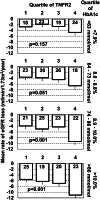Synergism between circulating tumor necrosis factor receptor 2 and HbA(1c) in determining renal decline during 5-18 years of follow-up in patients with type 1 diabetes and proteinuria
- PMID: 24898299
- PMCID: PMC4140154
- DOI: 10.2337/dc13-1983
Synergism between circulating tumor necrosis factor receptor 2 and HbA(1c) in determining renal decline during 5-18 years of follow-up in patients with type 1 diabetes and proteinuria
Abstract
Objective: We studied the serum concentration of tumor necrosis factor receptor 2 (TNFR2) and the rate of renal decline, a measure of the intensity of the disease process leading to end-stage renal disease (ESRD).
Research design and methods: A cohort of 349 type 1 diabetic patients with proteinuria was followed for 5-18 years. Serum TNFR2, glycated hemoglobin A1c (HbA1c), and other characteristics were measured at enrollment. We used a novel analytic approach, a joint longitudinal-survival model, fitted to serial estimates of glomerular filtration rate (eGFR) based on serum creatinine (median seven per patient) and time to onset of ESRD (112 patients) to estimate the rate of renal decline (eGFR loss).
Results: At enrollment, all patients had chronic kidney disease stage 1-3. The mean (±SD) rate of eGFR loss during 5-18 years of follow-up was -5.2 (±4.9) mL/min/1.73 m(2)/year. Serum TNFR2 was the strongest determinant of renal decline and ESRD risk (C-index 0.79). The rate of eGFR loss became steeper with rising concentration of TNFR2, and elevated HbA1c augmented the strength of this association (P = 0.030 for interaction). In patients with HbA1c ≥10.1% (87 mmol/mol), the difference in the rate of eGFR loss between the first and fourth quartiles of TNFR2 was 5.4 mL/min/1.73 m(2)/year, whereas it was only 1.9 in those with HbA1c <7.9% (63 mmol/mol).
Conclusions: Circulating TNFR2 is a major determinant of renal decline in patients with type 1 diabetes and proteinuria. Elevated HbA1c magnifies its effect. Although the mechanisms of this synergism are unknown, our findings allow us to stratify patients according to risk of ESRD.
© 2014 by the American Diabetes Association. Readers may use this article as long as the work is properly cited, the use is educational and not for profit, and the work is not altered.
Figures



References
-
- Henderson R, Diggle P, Dobson A. Joint modelling of longitudinal measurements and event time data. Biostatistics 2000;1:465–480 - PubMed
Publication types
MeSH terms
Substances
Grants and funding
LinkOut - more resources
Full Text Sources
Other Literature Sources
Medical
Molecular Biology Databases
Research Materials
Miscellaneous

